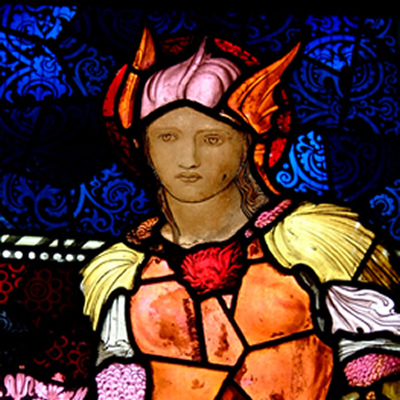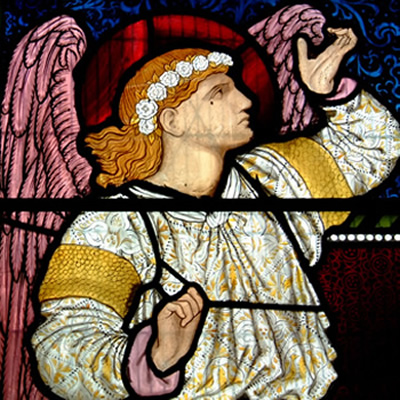The Pre-Raphaelite Brotherhood was a group of English painters, poets and critics, founded in 1848 by John Everett Millais, Dante Gabriel Rossetti and William Holman Hunt. They were particularly fascinated by medieval art which they considered embodied a spiritual and creative integrity that had been lost in the intervening years.
After 1856, Rossetti became associated with William Morris already closely allied to Edward Burne-Jones in a now much looser group interested in medievalism. He became a partner in the firm, Morris, Marshall, Faulkner & Co. and was an admirer of Morris’s wife, Jane Burden Morris who was a model for many paintings. Ford Madox Brown and Edward Burne-Jones also became partners in the firm. Through Morris’s company the ideals of the Pre-Raphaelite Brotherhood influenced many architects and designers, arousing interest in medieval designs, as well as other crafts. The windows of the North Aisle, the Lady Chapel and the South Chancel windows produced by the Morris firm are based on Pre-Raphaelite designs.

Of the four windows in the Lady Chapel in Christ Church, Southgate representing the four Evangelists, the first on the left which is of St. Mathew writing on a scroll, is an early design by Morris, though the Gothic canopy and emblem in a four-foil panel which completes the window was the work of Philip Webb. The image of St. Mathew is reputed to be a self portrait of Morris. Over the altar the figure of St Luke, sitting in a pew and looking towards the right and next to it, the figure of St. John, leaning forward and writing on his knee, are also attributed to Morris.
The Christ Church Southgate windows based on Edward Burne-Jones designs include the eight windows of the North Aisle representing the Christian virtues. The windows were all given to the church as memorials over a period of forty years following its dedication. Although the windows were installed at different times, there is remarkable consistency in the drawing, colouring and surrounds. Morris & Co clearly carried a complete set of Burne-Jones cartoons. In the studio the drawing would be reproduced to fit the window for which it was commissioned and the background and surround would be designed by another artist. In the case of Christ Church Southgate Philip Speakman Webb was responsible for most of the ornamental detail. There are samples of his work in the Victoria and Albert Museum.
Burne-Jones also designed the two large lancet windows in the chancel on the left when facing the altar. The Times obituary for Burne-Jones refers to ‘a loveliness of colour’ in his work and the windows in Christ Church Southgate show his full range from the strength of the North Aisle images to the delicacy of the chancel windows. The left chancel window represents Dorcas standing over a seated bareheaded girl offering her a cloak. (‘I was naked and ye clothed me’ Mathew 25:36). The right hand window shows the Good Samaritan comforting a traveller who is lying on the ground by holding a flask to his lips. (‘I was sick and ye visited me.’)
Burne-Jones’ account book records ‘Southgate. Small design of good Samaritan and touching photograph if needful…£10. (Charles Sewter ‘The Stained Glass of William Morris and His Circle – A Catalogue’) Sewter suggests that this is unmistakable evidence that the cartoons were prepared by photographic enlargements of Burne-Jones’s smaller drawings.





